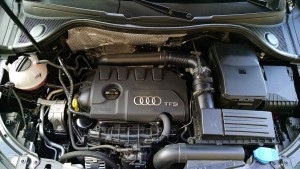Because the the 2016 Audi Q3 is still based on the older A5 or Golf V architecture, it was not updated with the latest generation of the 2.0 VW/Audi EA888 engine. This means that it’s one generation back of what most VW and Audi models now have.
What you see here is the CCTA version of the EA888 direct-injected and turbocharged four-cylinder, in the Audi Q3 rated at 200 horsepower and 207 pound-feet of torque. For that it requires premium unleaded fuel, but will run on regular but at a lower output level. It’s mated to a six-speed automatic transmission in the Q3.
For power and fuel economy the engine features variable valve timing on the intake side and direct fuel injection. You can’t see much of the fuel system here with exception of the cam drive high-pressure fuel pump.
The rest of its apparatus including a high-pressure fuel rail and fuel-injectors is hidden down below the intake manifold. There the injectors reach directly into the combustion chamber which has a relatively mild 9.6:1 compression ratio, common on turbocharged engines.
The engine itself features an iron block with two rotating balance shafts driven by the cam. These shafts offset vibrations from the rotating assembly of the crankshaft, rods and pistons which results in a much smoother and refined feel. Its cylinder head is of course aluminum.
Following the air-flow, the intake charge comes into the filter box just behind the grille, and then heads up through a tube toward the firewall then around the back of the engine to its turbocharger. You can’t see it well from above, but the water-cooled turbocharger is located down low at the back of the engine.
One key difference here between this engine and the latest generation of the EA888 is its cast-iron exhaust manifold the turbocharger mounts to. On the newer design, the exhaust manifold is integrated into the head for better thermal efficiency.
From the turbocharger, the air travels up to a large inter-cooler mounted ahead of the radiator and behind the grille. Once cooled, air then heads up into the throttle body low on the front of the engine and then into a plastic intake manifold which features flapper valves to control flow at different engine speeds.
Looking around the engine compartment, service points are mostly easy to find and access. Windshield washer fluid is up front at the driver side, behind it the air-filter box. Nice location, but opening it and replacing the filter does require some effort.
Behind that is the battery which is nicely shrouded in a handsome cover, next to it the fuse block. The brass post you see is a negative ground to use when you’re jump starting the Q3 or another vehicle.
 Getting to the brake fluid is a bit trickier, it’s located down low under the intake air tube. Checking it will require some gymnastics, filling it definitely needs a long tube funnel. Removing the air tube might make it all easier.
Getting to the brake fluid is a bit trickier, it’s located down low under the intake air tube. Checking it will require some gymnastics, filling it definitely needs a long tube funnel. Removing the air tube might make it all easier.
On the other side is the oil dipstick, filler cap and even the oil filter right up high where you can change it very easily. It’s a shame they all can’t be up here. The coolant reservoir is also up top at the passenger side.
Looking back up toward the front you can see electric fans on the radiator which do run after the engine is off, so watch your hands. The radiator support here is made of molded plastic to save weight, and on our Q3 are LED headlights, the housings and power unit seen here.
























